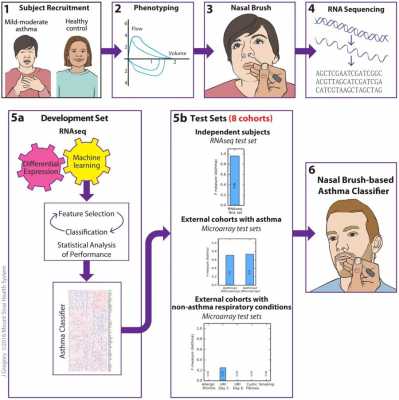12 Jun New Test Can Identify Asthma With Nasal Brush Biomarker
MedicalResearch.com Interview with:
Dr. Supinda Bunyavanich MD
Pediatric Allergy and Immunology
Physician and researcher at the Icahn School of Medicine.
MedicalResearch.com: What is the background for this study? What are the main findings?
Response: In this study, we report on an accurate asthma biomarker we have developed based on a simple nasal brush.
Asthma is a chronic respiratory disease that affects 10% of children and adults in the U.S. Mild to moderate asthma can be difficult to diagnose because symptoms change over time and can be complicated by other respiratory conditions. Given the high prevalence of asthma, there is high potential impact of improved diagnostic tools on reducing morbidity and mortality from asthma.
Current diagnostic tools for asthma, including spirometry and bronchoscopy, require specialized equipment and expertise to operate properly. Many individuals, particularly young children, have difficulty with pulmonary function testing because it requires, coordinated, forced breaths into a device. Spirometry results are unreliable when done with poor technique. Bronchoscopy is not practical for mild to moderate symptoms. For these reasons, asthma is often diagnosed and managed based on self-reporting of symptoms This can be unreliable, resulting in repeated doctor visits and even trips to the ER. Thus, a biomarker test for asthma that is easy to implement and interpret is highly desirable for the diagnosis and management of asthma.
MedicalResearch.com: What should readers take away from your report?
Response: This simple, inexpensive test is easy to collect in a doctor’s office and results are determined with basic follow-up data-analysis.
The biomarker was identified using machine learning algorithms.
MedicalResearch.com: What recommendations do you have for future research as a result of this work?
Response: A recommended future direction of the study is to recruit additional cohorts for nasal gene expression and profiling and extend validation of our findings in a prospective manner.
MedicalResearch.com: Is there anything else you would like to add?
Response: We’re hopeful that further studies can help bring this test into primary care settings, transforming the ease and accuracy of diagnosing asthma and our ability as doctors to appropriately treat our patients.
Conributed quote from first author, Gaurav Pandey, Ph.D. “One of the most exciting components of this study is demonstrating the power of machine learning when applied to biomedical data. Collaborations between computational scientists and biomedical researchers and clinicians are advancing medicine at an inspiring pace – we have the power of insights we didn’t have many of in the past and that opens a window to an entirely new world of diagnostic tools and treatments.”
This study was supported in part by the US National Institutes of Health (NIH R01AI118833, K08AI093538, R01GM114434) and the Icahn Institute for Genomics and Multiscale Biology, including computational resources provided by Scientific Computing at the Icahn School of Medicine at Mount Sinai
Citation:
Gaurav Pandey, Om P. Pandey, Angela J. Rogers, Mehmet E. Ahsen, Gabriel E. Hoffman, Benjamin A. Raby, Scott T. Weiss, Eric E. Schadt, Supinda Bunyavanich. A Nasal Brush-based Classifier of Asthma Identified by Machine Learning Analysis of Nasal RNA Sequence Data. Scientific Reports, 2018; 8 (1) DOI: 10.1038/s41598-018-27189-4
[wysija_form id=”3″]
The information on MedicalResearch.com is provided for educational purposes only, and is in no way intended to diagnose, cure, or treat any medical or other condition. Always seek the advice of your physician or other qualified health and ask your doctor any questions you may have regarding a medical condition. In addition to all other limitations and disclaimers in this agreement, service provider and its third party providers disclaim any liability or loss in connection with the content provided on this website.
Last Updated on June 12, 2018 by Marie Benz MD FAAD

